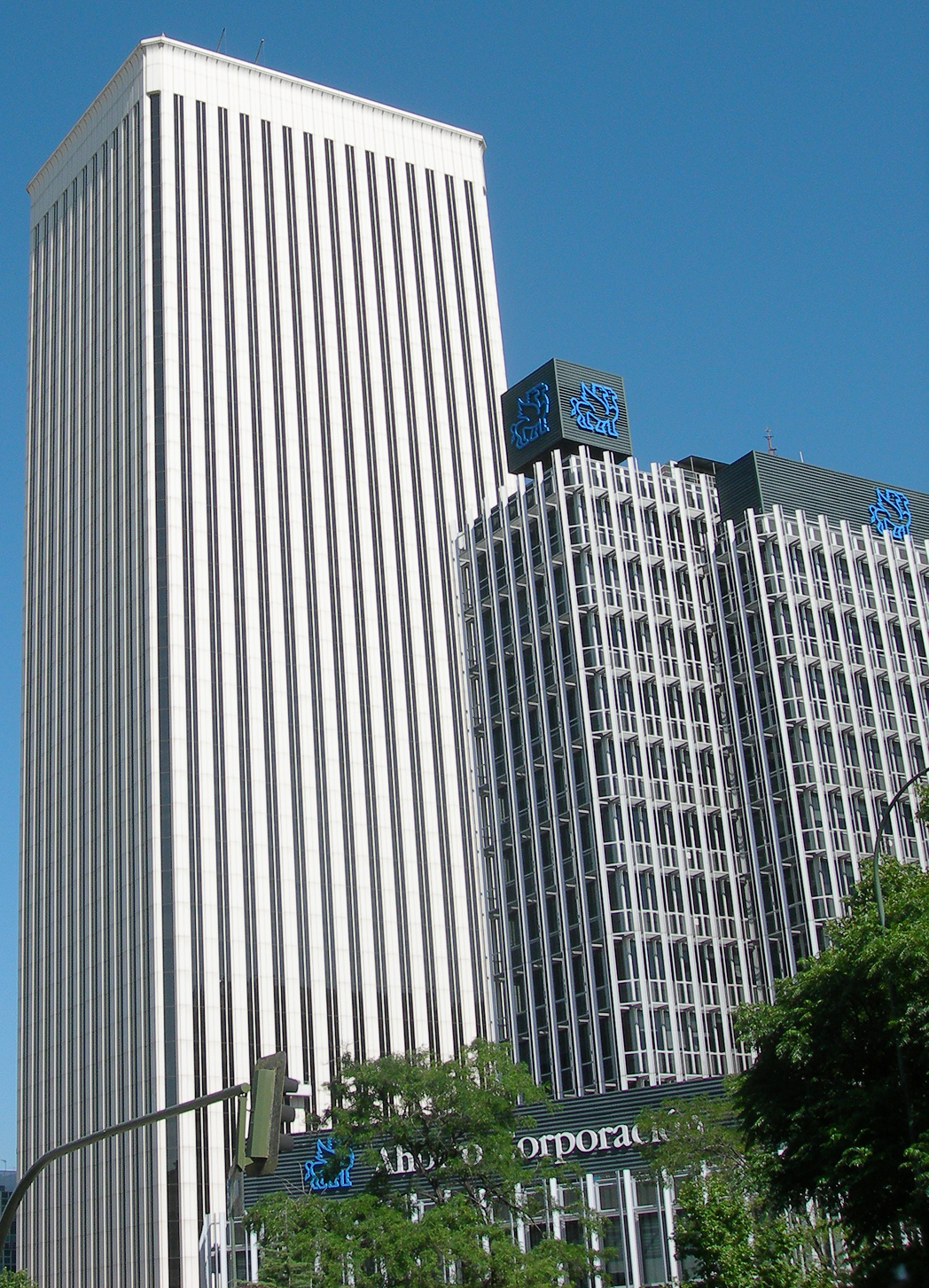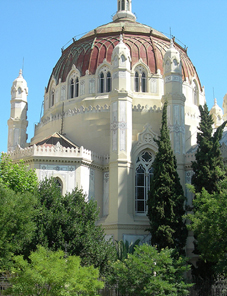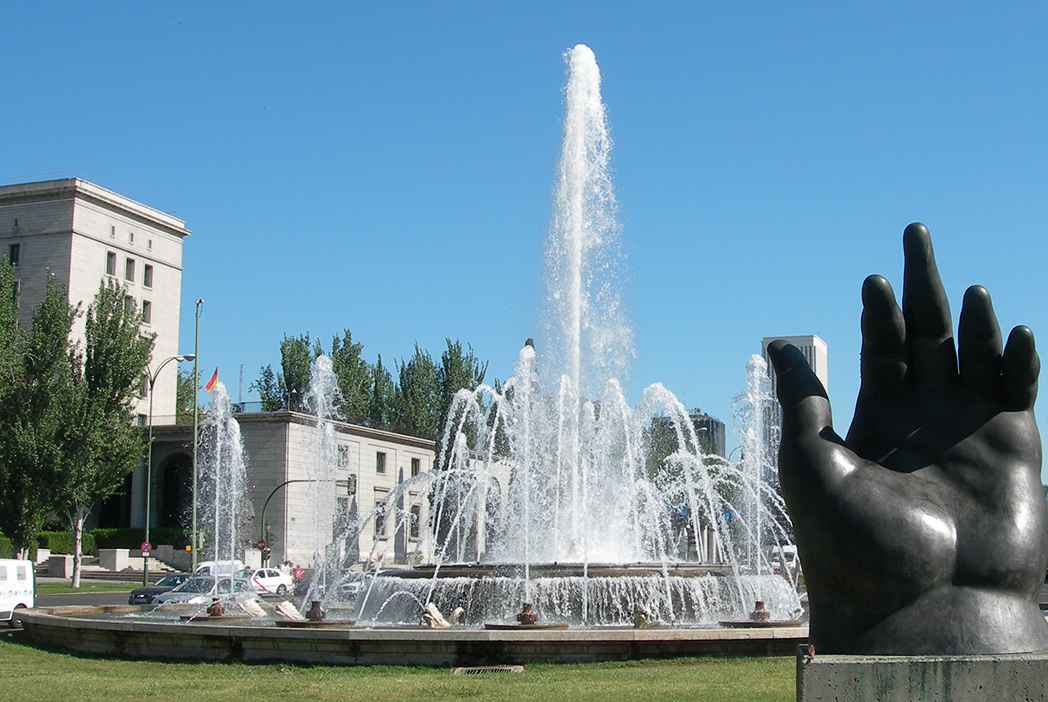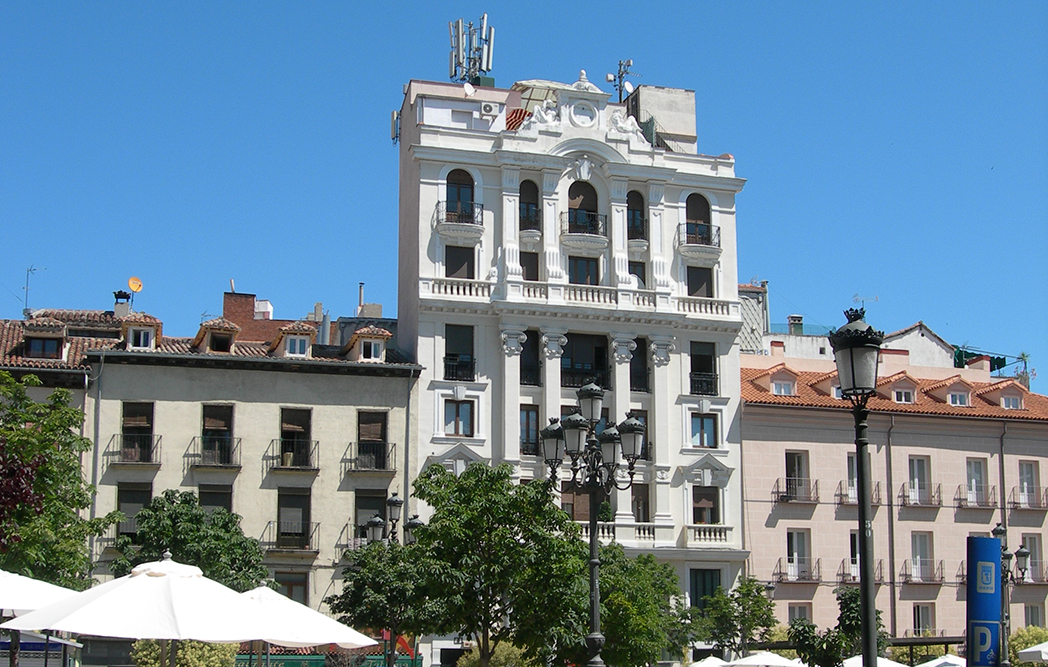 |
 |
 |
Picasso
Tårnet (Torre Picasso),
1989, er en kontorbygning i 43 etager beliggende på
Plaza de Pablo
Ruiz Picasso. Tårnet er tegnet af den amerikanske
arkitekt Minoru Yamasaki (1912-1986), der også tegnede
World
Trade Centers tvillingetårne.
Picasso Tower (Torre Picasso), 1989, is a 43-storey
office block situated at Plaza de Pablo
Ruiz Picasso. The tower is designed by the American
architect Minoru Yamasaki (1912-1986) best known for the
twin
Towers of The World Trade Center in New York. |
 |
|
|
|
|
|
|
|
1-2 |
Madridtårnet
(Torre
de Madrid), 1957, i 34 etager beliggende på Plaza de
España er tegnet af arkitekterne og brødrene Joaquín
og Julián Otamendi.
Madrid Tower (Torre de Madrid), 1957, a 34-storey
building situated at Plaza de España designed by the
architects and brothers Joaquín og Julián Otamendi. |
|
3 |
Castelartårnet (Torre Castelar),
1975, tegnet af tegnestuen Rafael de la-Hoz.
Castelar Tower (Torre
Castelar). 1975, designed by The Rafael de La-Hoz
Architects' Studio. |
|
|
 |
|
|
|
1-2 |
Europatårnet (Torre Europa),
1975-1985, er en kontorbygning i 30 etager beliggende på
Paseo De La Castellana, tegnet af Miguel Oriol e Ybarra
(1933).
Europe Tower
(Torre Europa), 1989, an office block of 30 storeys
situated at Paseo De La Castellana designed by the
Spanish architect Miguel Oriol e Ybarra (1933). |
|
3-4 |
Telefónicabygningen, 1929, Madrids
første skyskraber, 14 etagers bygning, var
hovedkontoret for det nationale telefonselskab,
beliggende på Gran Via, tegnet af den amerikanske
arkitekt Louis S. Weeks, den spanske arkitekt Ignacio de
Cárdenas har tilføjet nogle detaljer.
Edificio Telefónica,
1929, Madrid's first skyscraper, 14-storey office
block, was the headquarters of the Spanish telephone
company, situated in the Gran Via, designed by the
American architect Louis S. Weeks, the Spanish architect
Ignacio de Cárdenas has added some details. |
|
|
 |
|
|
|
1-3 |
Torre de Colón,
1976, 23 etagers kontorbygning på Plaza de Colón,
tegnet af arkitekten Antonio Lamela Martinez.
Torre de Colón,
1976, 23-storey office block situated at Plaza de Colón,
designed by the architect Antonio Lamela Martinez. |
|
4 |
Cervantes Instituttet
(Institute Cervantes), er en verdensomspændende
non-profit organisation grundlagt af den spanske
regering i 1991, hvis formål er at fremme det spanske
sprog og den spanske kultur. Instituttet har mere end 60
centre rundt omkring i verden. Det er opkaldt efter en
af de væsentligste spanske forfattere, Miguel de
Cervantes (1547-1616), der skrev romanen Don Quixote (1.
del 1605, 2. del 1615). Cervantes Instituttet blev
tildelt Prinsen af Asturiens pris i 2005 i kategorien
Kommunikation og Menneskelighed.
The Cervantes Institute (Institute Cervantes) is
a world-wide non-profit organization founded by the
Spanish Government in 1991 to promote Spanish language
and culture. It is now the largest international Spanish
teaching organization, it has more than 60 centers
around the world. The institute is named after one of
the most important Spanish writers Miguel de Cervantes
(1547-1616), most famous for Don Quixote (Part 1, 1605,
Part 2, 1615). The Institute was awarded The Prince of
Asturias Award in 2005 in the category Humanities and
Communication. |
|
|
 |
|
|
|
1 |
Edificio España, 1947-53, 25 etager, beliggende på
Plaza de España tegnet af arkitekterne Julian og Joaquin
Otamendi.
Cervantes Monumentet
ses foran bygningen.
Edificio España, 1947-53, 25 storeys, situated
at Plaza de España designed by the architects Julian and
Joaquin Otamendi. In front of the building The
Cervantes Monument. |
|
2-4 |
BBVA
Bygningen/Banco de Bilbao,
1980, 30-etagers bygning på Paseo de la Castellana
tegnet af arkitekten Francisco Javier Sáenz de Oiza.
BBVA står for Banco Bilbao Vizcaya Argentaria.
BBVA
Building/Banco de Bilbao,
1980, 30-storey building at Paseo de la Castellana
designed by the architect Francisco Javier Sáenz de
Oiza. BBVA stands for Banco
Bilbao Vizcaya Argentaria. |
|
|
 |
|
|
|
1-2 |
Plaza
de la Villa/Rådhuspladsen
Til venstre Casa de Cisneros (1537) tegnet for
Kardinal Cisneros af Benito Jimenez de Cisneros, og opført
i plateresque stil, der er en spansk arkitektur- og
ornamentstil karakteristisk for bygninger i begyndelsen
af 1500-tallet. Plateresque
er en fusion af sengotisk
stil med renæssanceelementer - en spansk version af den
italienske ungrenæssancestil. Bygningen huser i dag rådhuskontorer.
Til højre Casa de
la Villa, byens forhenværende
rådhus og fængsel, som blev tegnet i 1629 af Juan
Gomez de Mora og opført i perioden 1644-96. Ændringer
i nordfacaden (1785-89) blev tegnet af Juan de
Villanueva og udvidelser fra 1857-59 af Juan José Sánches
Pescador.
The Plaza de la Villa/Town Square.
To the left Casa de Cisneros (1537)
designed for Cardinal Cisneros by Benito Jiménez de
Cisneros and built in Plateresque style, which is a
style used in Spanish architecture and ornament in the
early 16th century. Plateresque is a fusion of Late
Gothic style including Renaissance elements - a Spanish
version of the Italian early Renaissance style. Today
the building houses various Town Hall departments. To
the right Casa de la Villa,
the former Town Hall and prison designed in 1629
by Juan Gomez de Mora and built in the period 1644-96.
Alterations to the North facade (1785-89) were made by
Juan José Sánches Pescador. |
|
|
 |
|
Plaza
de Cibeles |
 |
|
|
 |
|
|
 |
Plaza de
Cibeles
med
Palacio de Comunicaciones, der er byens
hovedpostkontor (påbegyndt
1904) tegnet af arkitekten
Antonio Palacios. Bygningens
arkitektoniske udtryk består
af elementer kendt fra
romansk og gotisk
kirkebyggeri.
Bygningen rummer Post- og
Telegraf Museet. Centralt på
pladsen er
Kybele Fontænen (1777-82), tegnet af den spanske
arkitekt Ventura Rodríguez,
udført i marmor. Den
romerske gudinde
Kybele/Cybele kendes også
som gudernes mor, Magna
Mater, hun var bjergenes og
hulernes gudinde, hun
herskede over de vilde dyr
og frugtbarhed. I fontænen
ses Kybele i en stridsvogn
der trækkes af to løver, der
oprindeligt var mennesker,
men blev forvandlet til
vilddyr, fordi de havde
ødelagt gudindens tempel.
Når Real Madrid vinder en
kamp flokkes fans omkring
fontænen for at hylde byens
hold. |
 |
Plaza de Cibeles with
Palacio de Comunicaciones,
the Head Post Office of Madrid (begun 1904)
designed by the architect Antonio
Palacios. The
building's architectural expression exists of elements
known from Romanesque and Gothic cathedrals. The
building contains the Postal and Telegraphic Museum. In
the middle of the Plaza is the Cibeles Fountain (1777-82)
designed by the Spanish architect Ventura Rodríguez,
executed in marble. The Roman goddess Cybele aka Magna
Mater, mother of all the gods, was also goddess of
mountains and caverns, she ruled over the wild animals
and fertility. In the fountain is Cybele placed in a
chariot pulled by two lions, originally people changed
into wild beasts, because they ruined the temple of the
goddess.
When Real Madrid wins a cup, fans flock around the
fountain to celebrate. |
|
|
 |
|
Plaza
Mayor |
 |
|
|
 |
|
|
|
|
 |
|
Plaza Mayor er Madrids
centrale plads planlagt af Filip 2. og hans arkitekt
Juan de Herrera, og indviet i 1620 under Filip 3. Juan
Gómes de Mora gav pladsen dens rektangulære form, og
efter at tre brande havde hærget pladsen fuldendte Juan
de Villanova den i 1853 ved at give den det udseende,
som den har i dag. Pladsen er omgivet af treetagers
beboelsesejendomme. Casa de la Panadería (bagerlaugets
hus) var pladsens første bygning, fuldført i
1590. Huset
havde en farverig facade med fresker, der er blevet
renoveret adskillige gange; senest i 1992, da facaden
blev dekoreret med fresker af maleren Carlos Franco.
Centralt på pladsen står en rytterstatue af Filip 3.
tegnet af skulptøren Giambologna og støbt i 1613 i
Firenze af Giambolognas elev, den italienske skulptør
Pietro Tacca. Statuen blev placeret på pladsen i 1847. |
 |
|
Plaza Mayor is the central square of Madrid planned
by Philip II and his architect Juan de Herrera, and
inaugurated in 1620 during Philip III. Juan Gómes de
Mora gave the plaza its rectangular form, and after
beeing damaged by fire three times, Juan de Villanova
gave it its present-day look in 1853.
The plaza is
surrounded by 3-storey residential properties.
The Casa de la Panadería (The Bakery House), the first
building completed in 1590 dominates the Plaza, the
building housed the bakers' guild. Originally the
building had a colourful facade of frescoes, which have
been renovated several times over the years, most
recently in 1992, when the frescoes were repainted using
designs by Carlos Franco.
The equestrian statue of Philip III
was designed by
the sculptor Giambologna and casted in 1613 in Florence
by Giambologna's pupil the Italian sculptor Pietro Tacca.
The statue was placed in the plaza in 1847. |
|
|
 |
|
|
|
1 |
Puerta de Alcalá/Alcalá Byporten
blev oprindeligt opført i 1599 for at hilse
Margarita af Østrig velkommen til Madrid som
kommende hustru til Kong Filip 3. I 1759 kørte Kong
Carlos 3. gennem porten og ind i Madrid, men fandt,
at den ikke var imposant nok som passage for
fornemme besøg, hvorfor han i 1764 beordrede porten
revet ned. Den italienske arkitekt Francesco
Sabatini (1722-1797) fik til opgave at bygge en ny,
som blev fuldført i 1769.
Puerta de Alcalá/Alcalá Gate
was originally constructed in 1599 to welcome the
future wife of King Felipe III, Margarita of Austria.
In 1759 King Charles III entered the city through
the gate and found it unworthy for such a noble use.
In 1764 he ordered the gate to be torn down and a
new one built. The Italian architect Francesco
Sabatini (1722-1797) received the commission. The
gate was completed 1769. |
|
2-3 |
Puerta de Toledo/Toledo Byporten
(1813-17) af arkitekten Antoni López Aguado, er den ene af Madrids to stadig eksisterende byporte (den anden er Puerta de Alcalá). Oprindelig var den planlagt som en triumfbue til ære for Napoleon 1. Den blev opført under hans brors, Josef 1. Bonapartes, regeringsperiode (1808-1813), men da den stod færdig blev den et symbol på den genindsatte kong Ferdinand 7. af huset Bourbon, som var Spaniens konge i 1808 og igen fra 1814-33. Han sad i fængsel i Frankrig under Napoleonskrigene.
Puerta de Toledo/Toledo Gate
(1813-17) by the architect Antoni López Aguado, is one of Madrid's two surviving city gates (the other is Puerta de Alcalá). Originally planned as a triumphal arch in honor of Napoleon I, it was built during the reign of his brother Joseph I Bonaparte (1808-1813), and when completed it became the symbol of the Bourbon King Ferdinand VII, who was king of Spain in 1808 and from 1814-33, and was imprisoned in France by Napoleon during the Napoleonic Wars. |
|
4 |
Edificio Metropolis 1709-11, 5-etagers kontorbygning beliggende på hjørnet af Calle de Alcalá og Gran Via af arkitekterne Jules og Raymond Février.
Edificio Metropolis, 1709-11, 5-storey office building situated on the corner of Calle de Alcalá and Gran Via, designed by the architects Jules and Raymond Février. |
|
|
 |
|
1-2 |
Statue af
Isabel II
(1830-1904), den ældste datter af Kong Ferdinand 7.,
og Spaniens første og eneste regerende dronning
(1836-1868).
Statue of Isabella II (1830-1904), eldest
daughter of King Ferdinand VII, and Spain's first
and only queen regnant (1836-1868). |
|
3 |
Madrid Opera House. |
|
4 |
Teatro Español. |
|
5 |
Parlamentsbygningen
(Congreso de los Diputados)/The
Parliament Building (Congreso
de los Diputados). |
|
|
|
 |
|
|
|
1-4 |
Estadio Santiago Bernabéu
1947, hjemmestadion for Real Madrid.
Estadio Santiago
Bernabéu,
1947, home stadium for Real Madrid. |
|
|
 |
|
|
 |
|
|
|
1 |
San Pedro el
Viejo, en af de
ældste kirker i Madrid/One of the oldest churches in Madrid. |
|
2 |
San Sebastián Atocha. |
|
3 |
San
Jerónimo
el Real. |
|
4 |
Basílica de San
Francisco el Grande/The National Pantheon. |
|
 |
 |
|
 |
|
Madrids gader/Streets of Madrid
|
 |
 |
 |
 |
 |
Skulpturen "Hånd" på
Paseo de la Castellana udført
af den colombianske maler og
skulptør Fernando
Botero Angulo (1932).
The
sculpture "Hand" on
Paseo de la Castellana executed
by the Colombian painter and
sculptor Fernando
Botero Angulo (1932). |
 |
 |
 |
 |
|
|
|
|
|
|
|
1-2 |
Madrids
symbol
"El
oso y el madroño"
(bjørnen og jordbærtræet) på et kloakdæksel. I den
romerske periode var der et stort antal brune bjørne
i området omkring Madrid.
The symbol of Madrid
"El oso y el madroño"
(the bear and the strawberry tree) on a
manhole
cover.
In
Roman times numerous brown bears inhabited the area
around Madrid. |
|
3 |
Neptunfontænen
(1780-1784) på Plaza de Cánovas del Castillo tegnet
af Ventura Rodríguez og udført i hvid marmor af
Juan
Pascual de Mena.
Fountain of Neptune
(1780-1784) at Plaza de Cánovas del Castillo,
designed by Ventura Rodríguez and executed in white
marble by Juan Pascual de Mena. |
|
 |
|
|
|
1 |
Springvand
på Paseo de la Castellana/Fountain
on Paseo de la Castellana. |
|
2-3 |
Manzanares floden/Manzanares river. |
|
|
 |
|
|
|
1-3 |
Levende skulpturer
og papirkunst på Plaza Mayor/Living sculptures
and paper art at Plaza Mayor. |
|
|
 |
|
|
|

